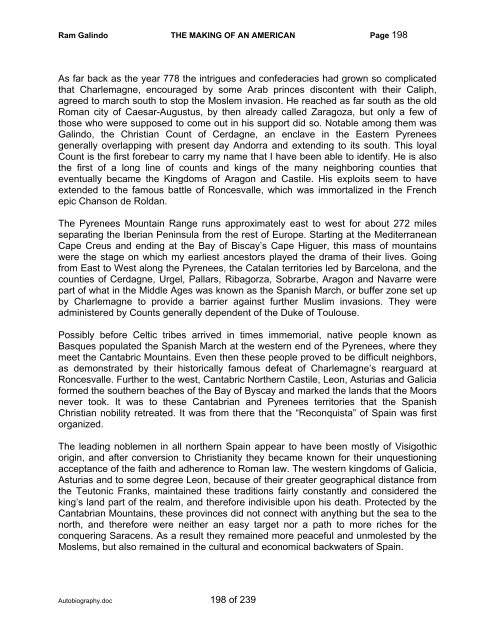Autobiography - The Galindo Group
Autobiography - The Galindo Group
Autobiography - The Galindo Group
Create successful ePaper yourself
Turn your PDF publications into a flip-book with our unique Google optimized e-Paper software.
Ram <strong>Galindo</strong> THE MAKING OF AN AMERICAN Page 198<br />
As far back as the year 778 the intrigues and confederacies had grown so complicated<br />
that Charlemagne, encouraged by some Arab princes discontent with their Caliph,<br />
agreed to march south to stop the Moslem invasion. He reached as far south as the old<br />
Roman city of Caesar-Augustus, by then already called Zaragoza, but only a few of<br />
those who were supposed to come out in his support did so. Notable among them was<br />
<strong>Galindo</strong>, the Christian Count of Cerdagne, an enclave in the Eastern Pyrenees<br />
generally overlapping with present day Andorra and extending to its south. This loyal<br />
Count is the first forebear to carry my name that I have been able to identify. He is also<br />
the first of a long line of counts and kings of the many neighboring counties that<br />
eventually became the Kingdoms of Aragon and Castile. His exploits seem to have<br />
extended to the famous battle of Roncesvalle, which was immortalized in the French<br />
epic Chanson de Roldan.<br />
<strong>The</strong> Pyrenees Mountain Range runs approximately east to west for about 272 miles<br />
separating the Iberian Peninsula from the rest of Europe. Starting at the Mediterranean<br />
Cape Creus and ending at the Bay of Biscay’s Cape Higuer, this mass of mountains<br />
were the stage on which my earliest ancestors played the drama of their lives. Going<br />
from East to West along the Pyrenees, the Catalan territories led by Barcelona, and the<br />
counties of Cerdagne, Urgel, Pallars, Ribagorza, Sobrarbe, Aragon and Navarre were<br />
part of what in the Middle Ages was known as the Spanish March, or buffer zone set up<br />
by Charlemagne to provide a barrier against further Muslim invasions. <strong>The</strong>y were<br />
administered by Counts generally dependent of the Duke of Toulouse.<br />
Possibly before Celtic tribes arrived in times immemorial, native people known as<br />
Basques populated the Spanish March at the western end of the Pyrenees, where they<br />
meet the Cantabric Mountains. Even then these people proved to be difficult neighbors,<br />
as demonstrated by their historically famous defeat of Charlemagne’s rearguard at<br />
Roncesvalle. Further to the west, Cantabric Northern Castile, Leon, Asturias and Galicia<br />
formed the southern beaches of the Bay of Byscay and marked the lands that the Moors<br />
never took. It was to these Cantabrian and Pyrenees territories that the Spanish<br />
Christian nobility retreated. It was from there that the “Reconquista” of Spain was first<br />
organized.<br />
<strong>The</strong> leading noblemen in all northern Spain appear to have been mostly of Visigothic<br />
origin, and after conversion to Christianity they became known for their unquestioning<br />
acceptance of the faith and adherence to Roman law. <strong>The</strong> western kingdoms of Galicia,<br />
Asturias and to some degree Leon, because of their greater geographical distance from<br />
the Teutonic Franks, maintained these traditions fairly constantly and considered the<br />
king’s land part of the realm, and therefore indivisible upon his death. Protected by the<br />
Cantabrian Mountains, these provinces did not connect with anything but the sea to the<br />
north, and therefore were neither an easy target nor a path to more riches for the<br />
conquering Saracens. As a result they remained more peaceful and unmolested by the<br />
Moslems, but also remained in the cultural and economical backwaters of Spain.<br />
<strong>Autobiography</strong>.doc 198 of 239


